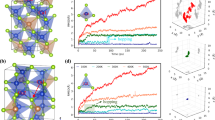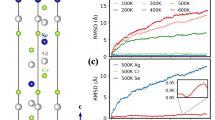Abstract
Superionic crystals exhibit ionic mobilities comparable to liquids while maintaining a periodic crystalline lattice. The atomic dynamics leading to large ionic mobility have long been debated. A central question is whether phonon quasiparticles—which conduct heat in regular solids—survive in the superionic state, where a large fraction of the system exhibits liquid-like behaviour. Here we present the results of energy- and momentum-resolved scattering studies combined with first-principles calculations and show that in the superionic phase of CuCrSe2, long-wavelength acoustic phonons capable of heat conduction remain largely intact, whereas specific phonon quasiparticles dominated by the Cu ions break down as a result of anharmonicity and disorder. The weak bonding and large anharmonicity of the Cu sublattice are present already in the normal ordered state, resulting in low thermal conductivity even below the superionic transition. These results demonstrate that anharmonic phonon dynamics are at the origin of low thermal conductivity and superionicity in this class of materials.
This is a preview of subscription content, access via your institution
Access options
Access Nature and 54 other Nature Portfolio journals
Get Nature+, our best-value online-access subscription
$29.99 / 30 days
cancel any time
Subscribe to this journal
Receive 12 print issues and online access
$209.00 per year
only $17.42 per issue
Buy this article
- Purchase on Springer Link
- Instant access to full article PDF
Prices may be subject to local taxes which are calculated during checkout




Similar content being viewed by others
Data availability
The data that support the plots within this paper and other findings of this study are available from the corresponding authors upon reasonable request.
References
Boyce, J. B. & Huberman, B. A. Superionic conductors: Transitions, structures, dynamics. Phys. Rep. 51, 189–265 (1979).
Brüesch, P. Phonons: Theory and Experiments I (Springer, Berlin, Heidelberg, 1982).
Mahan, G. D. & Roth, W. L. (eds.) Superionic Conductors (Springer, Boston, 1976).
Salamon, M. B. (ed.) Physics of Superionic Conductors (Springer, Berlin, Heidelberg, 1979).
Chandra, S. Superionic Solids: Principles and Applications (North-Holland, 1981).
Kamaya, N. et al. A lithium superionic conductor. Nat. Mater. 10, 682–686 (2011).
Kato, Y. et al. High-power all-solid-state batteries using sulfide superionic conductors. Nat. Energy 1, 16030 (2016).
He, X., Zhu, Y. & Mo, Y. Origin of fast ion diffusion in super-ionic conductors. Nat. Commun. 8, 15893 (2017).
Liu, H. et al. Copper ion liquid-like thermoelectrics. Nat. Mater. 11, 422–425 (2012).
Weldert, K. S., Zeier, W. G., Day, T. W., Panthöfer, M. & Snyder, G. J. Thermoelectric transport in Cu7SeP6 with high copper ionic mobility. J. Am. Chem. Soc. 136, 12035–12040 (2014).
Damay, F. et al. Localised Ag+ vibrations at the origin of ultralow thermal conductivity in layered thermoelectric AgCrSe2. Sci. Rep. 6, 23415 (2016).
Bailey, T. P. & Uher, C. Potential for superionic conductors in thermoelectric applications. Curr. Opin. Green Sustain. Chem. 4, 58–63 (2017).
Snyder, G. J. & Toberer, E. S. Complex thermoelectric materials. Nat. Mater. 7, 105–114 (2008).
Zebarjadi, M., Esfarjani, K., Dresselhaus, M. S., Ren, Z. F. & Chen, G. Perspectives on thermoelectrics: from fundamentals to device applications. Energy Environ. Sci. 5, 5147–5162 (2012).
Nolas, G. S., Sharp, J. & Goldsmid, J. Thermoelectrics: Basic Principles and New Materials Developments (Springer Verlag, Berlin Heidelberg, 2013).
Keppens, V. et al. Localized vibrational modes in metallic solids. Nature 395, 876–878 (1998).
Biswas, K. et al. High-performance bulk thermoelectrics with all-scale hierarchical architectures. Nature 489, 414–418 (2012).
Koza, M. M. et al. Breakdown of phonon glass paradigm in La- and Ce-filled Fe4Sb12 skutterudites. Nat. Mater. 7, 805–810 (2008).
Christensen, M. et al. Avoided crossing of rattler modes in thermoelectric materials. Nat. Mater. 7, 811–815 (2008).
Delaire, O. et al. Giant anharmonic phonon scattering in PbTe. Nat. Mater. 10, 614–619 (2011).
Ma, J. et al. Glass-like phonon scattering from a spontaneous nanostructure in AgSbTe2. Nat. Nanotech. 8, 445–451 (2013).
Voneshen, D. J. et al. Suppression of thermal conductivity by rattling modes in thermoelectric sodium cobaltate. Nat. Mater. 12, 1028–1032 (2013).
Lee, S. et al. Resonant bonding leads to low lattice thermal conductivity. Nat. Commun. 5, 3525 (2014).
Zhao, L.-D. et al. Ultralow thermal conductivity and high thermoelectric figure of merit in SnSe crystals. Nature 508, 373–377 (2014).
Li, C. W. et al. Orbitally driven giant phonon anharmonicity in SnSe. Nat. Phys. 11, 1063–1069 (2015).
Voneshen, D. J., Walker, H. C., Refson, K. & Goff, J. P. Hopping time scales and the phononl-liquid electron-crystal picture in thermoelectric copper selenide. Phys. Rev. Lett. 118, 145901 (2017).
Slack, G. A. in CRC Handbook of Thermoelectrics (ed. Rowe D. M.) Ch. 34 (CRC Press, Boca Raton, 1995).
Gascoin, F. & Maignan, A. Order–disorder transition in AgCrSe2: A new route to efficient thermoelectrics. Chem. Mater. 23, 2510–2513 (2011).
Danilkin, S. A. et al. Neutron scattering study of short-range correlations and ionic diffusion in copper selenide. Ionics 17, 75–80 (2011).
Bhattacharya, S. et al. CuCrSe2: A high performance phonon glass and electron crystal thermoelectric material. J. Mater. Chem. A 1, 11289–11297 (2013).
Gagor, A., Gnida, D. & Pietraszko, A. Order–disorder phenomena in layered CuCrSe2 crystals. Mater. Chem. Phys. 146, 283–288 (2014).
Li, B. et al. Liquid-like thermal conduction in intercalated layered crystalline solids. Nat. Mater. 17, 226–230 (2018).
Brüesch, P., Hibma, T. & Bührer, W. Dynamics of ions of the two-dimensional superionic conductor AgCrS2. Phys. Rev. B 27, 5052–5061 (1983).
Wakamura, K., Miura, F., Kojima, A. & Kanashiro, T. Observation of anomalously increasing phonon damping constant in the β phase of the fast-ionic conductor Ag3SI. Phys. Rev. B 41, 2758–2762 (1990).
Wakamura, K., Hirokawa, K. & Orita, K. Observation of characteristic phonon spectra for cage and mobile ions in the layered superionic conductor AgCrS2. J. Phys. Chem. Solids 57, 75–80 (1996).
Yakshibayev, R., Zabolotsky, V. & Almukhametov, R. Structural features and ionic transport in two-dimensional M x YSe2 (M = Cu, Ag; Y = Cr, Nb) mixed conductors. Solid State Ion. 31, 1–4 (1988).
Tewari, G. C., Tripathi, T. S., Yamauchi, H. & Karppinen, M. Thermoelectric properties of layered antiferromagnetic CuCrSe2. Mater. Chem. Phys. 145, 156–161 (2014).
Cheng, Y. et al. CuCrSe2 ternary chromium chalcogenide: Facile fabrication, doping and thermoelectric properties. J. Am. Ceram. Soc. 98, 3975–3980 (2015).
Yan, Y. et al. Sintering temperature dependence of thermoelectric performance in CuCrSe2 prepared via mechanical alloying. Scr. Mater. 127, 127–131 (2017).
Engelsman, F., Wiegers, G. A. & Jellinek, F. Crystal structures and magnetic structures of some metal (I) chromium (III) sulfides and selenides. J. Solid State Chem. 6, 574–582 (1973).
Squires, G. L. Introduction to the Theory of Thermal Neutron Scattering. 3rd edn (Cambridge Univ. Press, Cambridge, 2009).
Said, A. H., Sinn, H. & Divan, R. New developments in fabrication of high-energy-resolution analyzers for inelastic X-ray spectroscopy. J. Synchrotron Radiat. 18, 492–496 (2011).
Hempelmann, R. Quasielastic Neutron Scattering and Solid State Diffusion (Oxford Univ. Press, Oxford, 2001).
Chudley, C. T. & Elliot, R. J. Neutron scattering from a liquid on a jump diffusion model. Proc. Phys. Soc. 77, 353–361 (1961).
Bhattacharya, S. et al. High thermoelectric performance of (AgCrSe2)0.5(CuCrSe2)0.5 nano-composites having all-scale natural hierarchical architectures. J. Mater. Chem. A 2, 17122–17129 (2014).
Ehlers, G., Podlesnyak, A. A., Niedziela, J. L., Iverson, E. B. & Sokol, P. E. The new cold neutron chopper spectrometer at the Spallation Neutron Source: Design and performance. Rev. Sci. Instrum. 82, 085108 (2011).
Abernathy, D. L. et al. Design and operation of the wide angular-range chopper spectrometer ARCS at the Spallation Neutron Source. Rev. Sci. Instrum. 83, 015114 (2012).
Arnold, O. et al. Mantid—Data analysis and visualization package for neutron scattering and μSR experiments. Nucl. Instrum. Methods Phys. Res. Section A 764, 156–166 (2014).
Kresse, G. & Hafner, J. Ab initio molecular dynamics for liquid metals. Phys. Rev. B 47, 558(R) (1993).
Kresse, G. & Furthmüller, J. Efficient iterative schemes for ab initio total-energy calculations using a plane-wave basis set. Phys. Rev. B 54, 11169 (1996).
Kresse, G. & Furthmüller, J. Efficiency of ab-initio total energy calculations for metals and semiconductors using a plane-wave basis set. Comput. Mater. Sci. 6, 15–50 (1996).
Perdew, J., Burke, K. & Ernzerhof, M. Generalized gradient approximation made simple. Phys. Rev. Lett. 77, 3865–3868 (1996).
Tewari, G. C., Karppinen, M. & Rastogi, A. K. Effects of competing magnetic interactions on the electronic transport properties of CuCrSe2. J. Solid State Chem. 198, 108–113 (2013).
Togo, A. & Tanaka, I. First principles phonon calculations in materials science. Scr. Mater. 108, 1–5 (2015).
Carrete, J. et al. almaBTE: A solver of the space–time dependent Boltzmann transport equation for phonons in structured materials. Comput. Phys. Commun. 220, 351–362 (2017).
Tritt, T. M. (ed.) Thermal Conductivity: Theory, Properties, and Applications (Springer, Berlin, Heidelberg, 2005).
Acknowledgements
We thank O. Hellman and M. Stone for helpful discussions. We are grateful to J. Z. Tischler for algorithms enabling deconvolution of the energy resolution from the inelastic X-ray phonon scattering data. We would also like to acknowledge technical support from D. Dunning, T. Russell and S. Elorfi at the SNS. J.L.N., J.D. and T.L.-A. were supported as part of the S3TEC EFRC, an Energy Frontier Research Center funded by the US Department of Energy (DOE), Office of Science, Basic Energy Sciences under award no. DE-SC0001299. D.B. and O.D. were supported by the US DOE, Office of Science, Basic Energy Sciences, Materials Sciences and Engineering Division, under the Early Career Award no. DE-SC0016166 (principal investigator O.D.). A.F.M. was supported by the US DOE, Office of Science, Basic Energy Sciences, Materials Sciences and Engineering Division. The research at Oak Ridge National Laboratory’s Spallation Neutron Source was sponsored by the Scientific User Facilities Division, Office of Basic Energy Sciences, US DOE. This research used resources of the Advanced Photon Source, a US DOE Office of Science User Facility operated for the DOE Office of Science by Argonne National Laboratory under contract no. DE-AC02-06CH11357. Ab initio molecular dynamics calculations were performed using resources of the National Energy Research Scientific Computing Center, a US DOE Office of Science User Facility supported by the Office of Science of the US DOE under contract no. DE-AC02-05CH11231. Density functional theory simulations for this research used resources of the Oak Ridge Leadership Computing Facility at the Oak Ridge National Laboratory, which is supported by the Office of Science of the US DOE under contract no. DE-AC05-00OR22725.
Author information
Authors and Affiliations
Contributions
J.L.N., D.B. and O.D. performed and analysed the neutron scattering measurements with support from G.E. and D.L.A. J.L.N., D.B. and O.D. performed and analysed the X-ray measurements with support from A.S. A.F.M. synthesized the samples and performed transport measurements. T.L.-A. performed diffusivity and heat capacity measurements. D.B. and J.D. performed simulations. J.L.N., D.B. and O.D. wrote the manuscript and all authors commented on the manuscript. O.D. supervised the project.
Corresponding authors
Ethics declarations
Competing Interests
The authors declare that they have no competing interests.
Additional information
Publisher’s note: Springer Nature remains neutral with regard to jurisdictional claims in published maps and institutional affiliations.
Supplementary information
Supplementary Information
21 Figures, 3 Tables, 41 References
Rights and permissions
About this article
Cite this article
Niedziela, J.L., Bansal, D., May, A.F. et al. Selective breakdown of phonon quasiparticles across superionic transition in CuCrSe2. Nature Phys 15, 73–78 (2019). https://doi.org/10.1038/s41567-018-0298-2
Received:
Accepted:
Published:
Issue Date:
DOI: https://doi.org/10.1038/s41567-018-0298-2
This article is cited by
-
Extreme phonon anharmonicity underpins superionic diffusion and ultralow thermal conductivity in argyrodite Ag8SnSe6
Nature Materials (2023)
-
Electronic origin of the unusual thermal properties of copper-based semiconductors: The s-d coupling-induced large phonon anharmonicity
Science China Physics, Mechanics & Astronomy (2023)
-
Four-dimensional imaging of lattice dynamics using ab-initio simulation
npj Computational Materials (2021)
-
A two-dimensional type I superionic conductor
Nature Materials (2021)
-
Intrinsic nanostructure induced ultralow thermal conductivity yields enhanced thermoelectric performance in Zintl phase Eu2ZnSb2
Nature Communications (2021)



